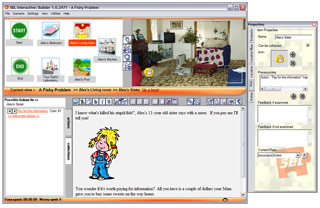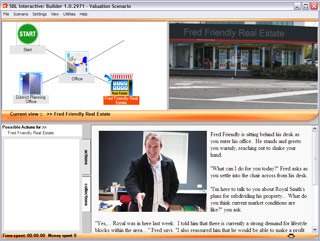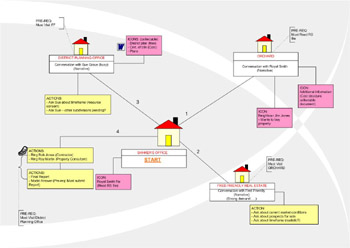Scenario-based Learning: A primer for using SBL Interactive
Author: Terry Stewart
Published 2006, Massey University.
126 pages plus CD-ROM.
Introduction
SBL Interactive (SBLi) is a suite of programs which allow for the creation and delivery of interactive, problem based scenarios both locally and over the Internet. The software itself is intuitive and easy-to-use but storyboarding scenarios and applying them in an educational context requires careful planning.
Scenario-based Learning: A primer for using SBL Interactive is a guide to planning, constructing and delivering interactive, problem-based scenarios using SBL Interactive. It is a book designed for teaching practitioners rather than educational academics hence the language is straightforward and as free from jargon as it can be without being too verbose. Although its focus is on SBLi use in tertiary education and professional training, this guide should prove just as useful to those in the secondary or primary sector.
What you get...
(i) A Tutorial
 Figure 1. Constructing the fishy scenario tutorial
Figure 1. Constructing the fishy scenario tutorial
After a brief introduction to problem-based learning, the book familiarises users with SBLi authoring by working through the construction of a simple scenario, step by step.
The tutorial can also be viewed as a narrated, screen-capture video.
(ii) Example Scenarios
 Figure 2 – Meet Fred your friendly real estate agent. From the Commerce scenario.
Figure 2 – Meet Fred your friendly real estate agent. From the Commerce scenario.
The next section in the manual illustrates and discusses 16 example scenarios in a wide range of subject areas including Agriculture, Business, Medicine and Veterinary Studies, Creative Arts, Earth Science, Law, Hospitality, Engineering and Social Work to name a few.
These examples, some containing video and sound, demonstrate different features of the program, and also how interactive scenarios may be used at differing times, and under differing assessment regimes, within a course. The examples can also be adapted for your own use.
(iii) Techniques
 Figure 3. Planning a SBLi scenario
Figure 3. Planning a SBLi scenario
Following the exemplar discussion there is a whole chapter devoted to storyboarding and planning an interactive scenario.
The book closes with tips and techniques for delivering these scenarios to students.
(iv) Item and location graphics






Figure 4 - A selection of icons from the image library
Along with a tutorial and example lessons the bundled CD-ROM includes a library of 113 icons for use within SBLi.
(v) Bonus Program. Challenge FRAP
Also included on the CD-ROM is a bonus electronic workbook program for student assignments, Challenge FRAP (form for the analysis of problems).
FRAP is designed to facilitating the scaffolding and recording of a problem-based exercise. It uses a familiar Windows “file management” interface to record tasks in easy digestible steps, while showing how they relate to one another.
About the Author
Dr. Terry Stewart, has both used, and explored the use of, interactive problem-based scenarios within his own teaching discipline for over 15 years. He won a New Zealand national award for Innovative teaching in 2003 and has collaborated closely with the makers of SBLi during its development and the development of earlier, similar programs.